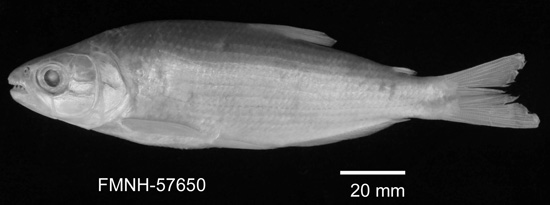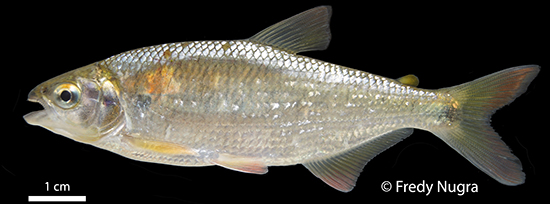Characidae - Brycon atrocaudatus (Kner, 1863) |
 |  |
| SOURCE FOR OCCURRENCE IN ECUADOR: This species is very common in the Guayas and Esmeraldas drainages. There are many references for its occurrence in the area (e.g., Eigenmann, 1922; Bohlke, 1958; Ovchynnyk, 1971; Gery, 1977; Glodek, 1978; Howes, 1982; Laaz & Torres, 2010). |
| ORIGINAL DESCRIPTION: Kner, 1863. Eine Uebersicht der ichthyologischen Ausbeute des Herrn Professors Dr. Mor. Wagner in Central-Amerika. Sitzungsberichte der Koningl. Bayerischen Akademie der Wissenschaften, Munchen 2:220-230. |
| TYPE SPECIMENS: |
| TAXONOMIC STATUS: Valid (Eschmeyer and Fricke, 2011). However, Howes (1982) indicated that the type specimens were missing. In addition, the figures from the original description seem to differ from those in Eigenmann (1922), suggesting that some taxonomic problems may exist. Brycon ecuadoriensis from the Guayas River drainage, seems to be a synonym of B. atrocaudatus (Howes, 1982; Eschmeyer and Fricke, 2011). |
| RANGE ECUADOR: Drainages of western Ecuador (Howes, 1982). |
| RANGE OUTSIDE OF ECUADOR: Northern Peru, Piura River (Eigenmann, 1922). |
| COLLECTIONS IN ECUADOR: |
| MAXIMUM SIZE: 40 cm TL (Fishbase, 2011). |
| DISTINGUISHING FEATURES: Brycon atrocaudatus differs from other species by the presence of fifty-six to fifty nine lateral scales, lower jaw a little shorter than the upper, snout moderately pointed, mandible with ten or eleven similar teeth (Eigenmann, 1922). This species can be distinguished from B. alburnus and B. dentex because the latter two species have longer snouts (Howes, 1982). |
|
 |
Top: Brycon alburnus. Middle: Brycon atrocaudatus. Bottom: Brycon dentex. Note differences in body shape and head shape, particularly snout length and dentition. Brycon alburnus has a long snout with large teeth, including canine like teeth. Brycon atrocaudatus has a snout of intermediate length with regular peg-like teeth. Brycon dentex has a short snout with small teeth. All specimens were purchased from fishermen in Santa Rosa, El Oro Province, southwestern Ecuador.
|
|
| ECOLOGY: This species is known in Ecuador as the "dama". It is a large, ecologically important omnivorous fish. |
| ECONOMIC IMPORTANCE: This is an important food fish for people in rural parts of western Ecuador (Revelo, 2010). |
| CONSERVATION STATUS: NA, although this species is heavily exploited as a food species. |
| LINK TO FISHBASE PAGE: Click here for link |
| SPECIES PROFILE CREATED BY: Enrique Laaz |
| SPECIES PROFILE CONTRIBUTORS: Windsor Aguirre, Fredy Nugra |
|
|
|
|
|

